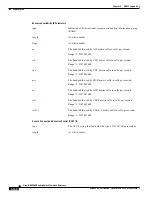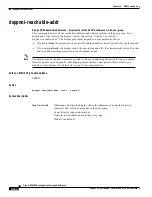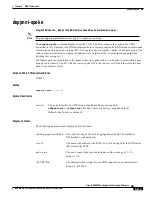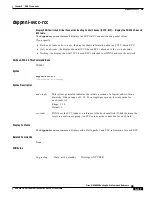
5-113
Cisco MGX 8850 Routing Switch Command Reference
Release 2.0, Part Number 78-10467-04 Rev C0, October 2001
Chapter 5
PNNI Commands
dsppnni-spoke
dsppnni-spoke
Display PNNI Spoke—display the PNNI complex node default advertisement values.
Note
This debugging command does not apply to single-peer groups.
The dsppnni-spoke command displays how the UNI 4.0 address scope values map to the PNNI
hierarchal levels. It displays the PNNI default spoke for a logical group node (LGN) using complex node
representation in a given peer group (PG). The spoke is the conceptual “radius” of the peer group. The
spoke values are based on averaging the administrate weights (AWs) of all border node paths then
dividing that average by 2.
If a logical path is not included in the bypass table, the spoke values can be used to select which peer
group a route transits. The PG with the lowest spoke AW is the lowest cost PG and therefore the best
path to use (based on AW).
Cards on Which This Command Runs
PXM45
Syntax
dsppnni-spoke <node-id>
Syntax Description
Display Contents
The following parameters are displayed for each node.
node-id
The node identifier of a PNNI logical node can be user-assigned by
addpnni-node or cnfpnni-node but also comes as a factory-assigned default.
Default: (the factory-set default)
nodal aggregation method
The ASCII string of the active aggregation method. The method is
full-meshed or spanning tree.
ptse-id
The unique identifier for the PTSE. ptse-id is assigned by the PNNI node
that created the PTSE.
node-index
The node-index is the local node index and has a range of 1–10.
Range: 1–10
AW-NRTVBR
The administrative weight for nrt-VBR connections on this interface.
Range: 0–4194304
















































